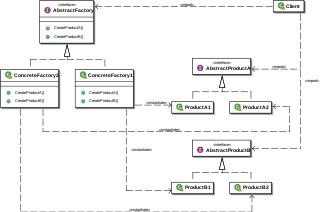
The abstract factory pattern in software engineering is a design pattern that provides a way to create families of related objects without imposing their concrete classes, by encapsulating a group of individual factories that have a common theme without specifying their concrete classes. According to this pattern, a client software component creates a concrete implementation of the abstract factory and then uses the generic interface of the factory to create the concrete objects that are part of the family. The client does not know which concrete objects it receives from each of these internal factories, as it uses only the generic interfaces of their products. This pattern separates the details of implementation of a set of objects from their general usage and relies on object composition, as object creation is implemented in methods exposed in the factory interface.
In programming languages, a closure, also lexical closure or function closure, is a technique for implementing lexically scoped name binding in a language with first-class functions. Operationally, a closure is a record storing a function together with an environment. The environment is a mapping associating each free variable of the function with the value or reference to which the name was bound when the closure was created. Unlike a plain function, a closure allows the function to access those captured variables through the closure's copies of their values or references, even when the function is invoked outside their scope.

In software engineering, the singleton pattern is a software design pattern that restricts the instantiation of a class to a singular instance. One of the well-known "Gang of Four" design patterns, which describes how to solve recurring problems in object-oriented software, the pattern is useful when exactly one object is needed to coordinate actions across a system.

In computer programming, the flyweight software design pattern refers to an object that minimizes memory usage by sharing some of its data with other similar objects. The flyweight pattern is one of twenty-three well-known GoF design patterns. These patterns promote flexible object-oriented software design, which is easier to implement, change, test, and reuse.
In object-oriented programming, the decorator pattern is a design pattern that allows behavior to be added to an individual object, dynamically, without affecting the behavior of other instances of the same class. The decorator pattern is often useful for adhering to the Single Responsibility Principle, as it allows functionality to be divided between classes with unique areas of concern as well as to the Open-Closed Principle, by allowing the functionality of a class to be extended without being modified. Decorator use can be more efficient than subclassing, because an object's behavior can be augmented without defining an entirely new object.
In software design and engineering, the observer pattern is a software design pattern in which an object, named the subject, maintains a list of its dependents, called observers, and notifies them automatically of any state changes, usually by calling one of their methods.
In object-oriented (OO) and functional programming, an immutable object is an object whose state cannot be modified after it is created. This is in contrast to a mutable object, which can be modified after it is created. In some cases, an object is considered immutable even if some internally used attributes change, but the object's state appears unchanging from an external point of view. For example, an object that uses memoization to cache the results of expensive computations could still be considered an immutable object.
In computer programming, a function object is a construct allowing an object to be invoked or called as if it were an ordinary function, usually with the same syntax. In some languages, particularly C++, function objects are often called functors.
This article compares two programming languages: C# with Java. While the focus of this article is mainly the languages and their features, such a comparison will necessarily also consider some features of platforms and libraries. For a more detailed comparison of the platforms, see Comparison of the Java and .NET platforms.
In class-based, object-oriented programming, a constructor is a special type of function called to create an object. It prepares the new object for use, often accepting arguments that the constructor uses to set required member variables.

The syntax of Java is the set of rules defining how a Java program is written and interpreted.
In some programming languages, const is a type qualifier that indicates that the data is read-only. While this can be used to declare constants, const in the C family of languages differs from similar constructs in other languages in that it is part of the type, and thus has complicated behavior when combined with pointers, references, composite data types, and type-checking. In other languages, the data is not in a single memory location, but copied at compile time on each use. Languages which use it include C, C++, D, JavaScript, Julia, and Rust.
In the Java programming language, the final keyword is used in several contexts to define an entity that can only be assigned once.
Platform Invocation Services, commonly referred to as P/Invoke, is a feature of Common Language Infrastructure implementations, like Microsoft's Common Language Runtime, that enables managed code to call native code.
In software engineering, a fluent interface is an object-oriented API whose design relies extensively on method chaining. Its goal is to increase code legibility by creating a domain-specific language (DSL). The term was coined in 2005 by Eric Evans and Martin Fowler.
The circle–ellipse problem in software development illustrates several pitfalls which can arise when using subtype polymorphism in object modelling. The issues are most commonly encountered when using object-oriented programming (OOP). By definition, this problem is a violation of the Liskov substitution principle, one of the SOLID principles.
clone is a method in the Java programming language for object duplication. In Java, objects are manipulated through reference variables, and there is no operator for copying an object—the assignment operator duplicates the reference, not the object. The clone method provides this missing functionality.
This article describes the syntax of the C# programming language. The features described are compatible with .NET Framework and Mono.
In software engineering, the servant pattern defines an object used to offer some functionality to a group of classes without defining that functionality in each of them. A Servant is a class whose instance provides methods that take care of a desired service, while objects for which the servant does something, are taken as parameters.
In object-oriented programming, forwarding means that using a member of an object results in actually using the corresponding member of a different object: the use is forwarded to another object. Forwarding is used in a number of design patterns, where some members are forwarded to another object, while others are handled by the directly used object. The forwarding object is frequently called a wrapper object, and explicit forwarding members are called wrapper functions.



